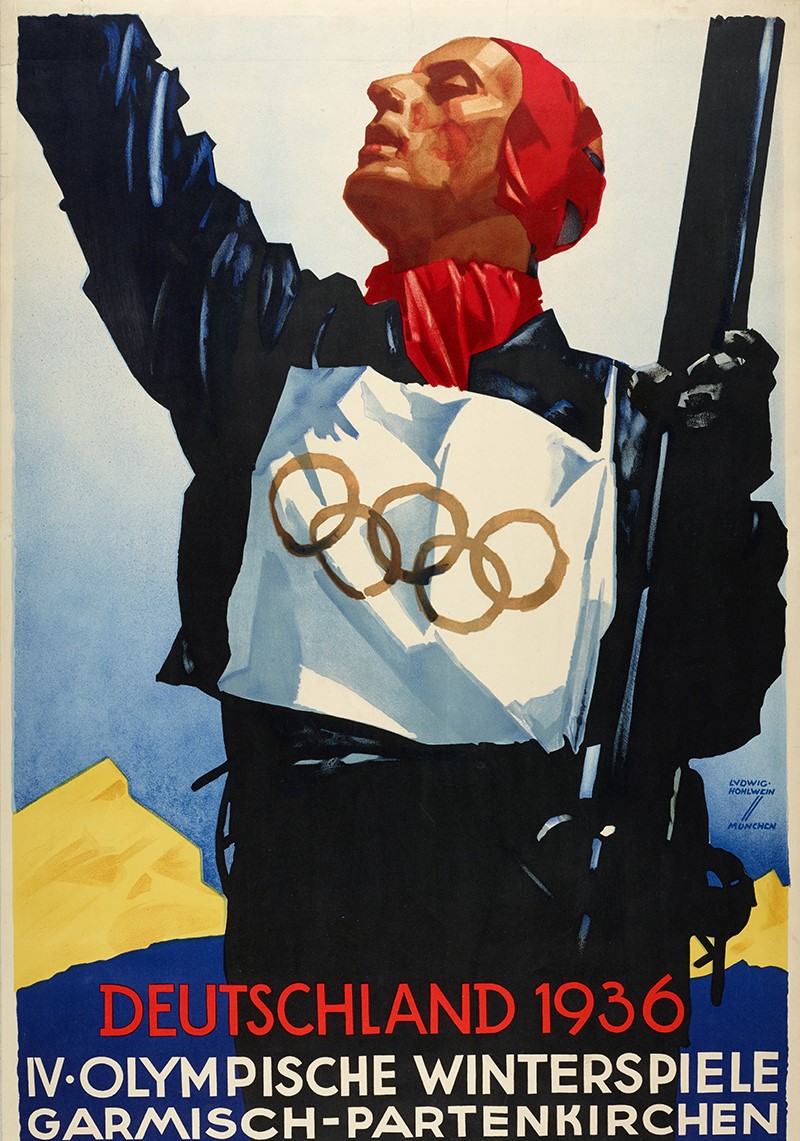The Winter Olympics of 1936 are not often recollected, trumped in the collective conscious by the summer edition in Berlin. But the reality is that they were two acts of the same tragedy, as the gross obscenity of Nazi Germany found a global stage.
In the first instance Adolf Hitler was not actually interested in sport; in 1932, a year after the Games had been secured, he condemned them as “a play inspired by Judaism which cannot possibly be put on in a Reich ruled by National Socialists”. But Joseph Goebbels, his Minister of Propaganda, appreciated another angle: “German sport has only one task,” he said in April 1933. “To strengthen the character of the German people, imbuing it with the fighting spirit and steadfast camaraderie necessary in the struggle for its existence.”
Thus did he convince Hitler and as such the Games went ahead as planned – by which time the Nazis had also taken control of Grand Prix racing and sequestered the brilliance of Max Schmelling’s boxing. The intention was to exploit all three to maximum degree.
1. In the heart of evil
In those days, winter and summer Games were staged in the same country. Though Berlin was the obvious summer selection, the winter venue was less well known: Garmisch-Partenkirchen, twin Bavarian market towns forcibly amalgamated for the purpose. Hans van Tschammer und Osten, installed as Germany’s Reichsportfuhrer, appointed Karl Ritter von Halt as President of the German League of the Reich for Physical Exercise, and it would be his job to ensure that everything ran smoothly.
The period leading up to the Games was difficult. So virulent was local antisemitism that Von Halt was worried; not, he hastened to add, “in order to help the Jews”, but “if the propaganda is continued in this form, the population of Garmisch-Partenkirchen will be so inflamed that it will indiscriminately attack and injure anyone who even looks Jewish.”
When Henri de Baillet-Latour, president of the International Olympic Committee, visited the town on a recce, he allegedly informed Hitler that all its antisemitic placards and posters would need removing. Hitler acquiesced, the vicious Der Stürmer tabloid was also withdrawn, and presto! Germany was the perfect venue for a celebration of the human race.
Adolf Hitler attends the opening ceremony in 1936 (IOC)
Image credit: Other Agency
USA, Britain and France all voiced their opposition to the tenor of things, refusing to compete if there would be discrimination against Jews – which there wasn’t if you looked away. So away they looked; as the saying goes, “Je mehr sich die Dinge ändern, um so mehr bleiben sie sich gleich”; the more things change, the more they stay the same.
Originally, Jews – in the form of Rudi Ball – were barred from competition. At just 5”4 and 140lb, Ball was everything the Reich hated – except he was also a brilliant ice hockey player. Aged 15, he’d gone to watch a match between two of Europe’s best teams, Berliner SC and Wiener EV, at which he was inspired by Blake Watson, a Canadian medical student who played for the visitors. So he prevailed upon his father to buy him some expensive Canadian skates – size 6! – and by 17, was playing for Berliner himself, a member of Europe’s strongest forward line thanks to his phenomenal stickwork, speed, bravery and awareness. In 1929, Ball scored the winning goal in the German championship match, and a year later his two brothers were alongside him as BSC became champions again.
In 1931, Ball excelled in his first World Championship, scoring in the final as Germany were walloped by Canada, and a year later a French newspaper named him the best player in Europe – ahead, even, of Watson. Then, in 1932, he was Germany’s best player as they won the bronze at the Lake Placid Olympics.
Still, principles were principles, so Ball was left out of a squad also notable for including splendidly named Joachim Albrecht von Bethmann-Hollweg. But Gustav Jaenecke, Ball’s line partner and friend, bravely refused to play in his absence – which in a way got the Nazis out of a bind: by relenting they saved the team from uselessness, and could also no longer be accused of refusing to pick Jews. And Ball took advantage too, negotiating a passage out of Germany for his family; he, on the other hand, remained in the country throughout the war, entertaining capacity crowds despite his inherent Jewishness, before leaving in 1948 to join his brother Heinz in Johannesburg.
2. Propaganda and fame
The opening ceremony of the 1936 Garmisch Games (IOC)
Image credit: Other Agency
As the Games drew nearer, there remained one significant problem: the elements could not be bullied into complying with the Aryan imperative, daring to deliver a January thaw – a particular problem given that Alpine skiing was making its event debut. There was talk of postponing the opening ceremony and replacement runs were prepared higher up the mountains, while a thousand soldiers moved snow lower down the mountains, to cover up green patches. But one day of weather remedied the situation, and everything was good to go at the appointed time.
Meanwhile, Eric Phipps, the British ambassador in Berlin, telegraphed Anthony Eden, the Foreign Secretary: “The German government attach enormous importance to the Olympic Games from the point of view of propaganda,” he said, “and hope to be able to take the opportunity of impressing foreign countries with the capacity and solidity of the Nazi regime". By this time, Jews had been banned from the legal profession, were no longer permitted national health insurance and had been stripped of citizenship; the Night of the Long Knives had seen Hitler kill his political rivals; abortions were forced upon women carrying hereditary diseases; the Nuremberg Laws had been enacted; and three months after the Games were done, Germany invaded the Rhineland. Capacious and solid or what?
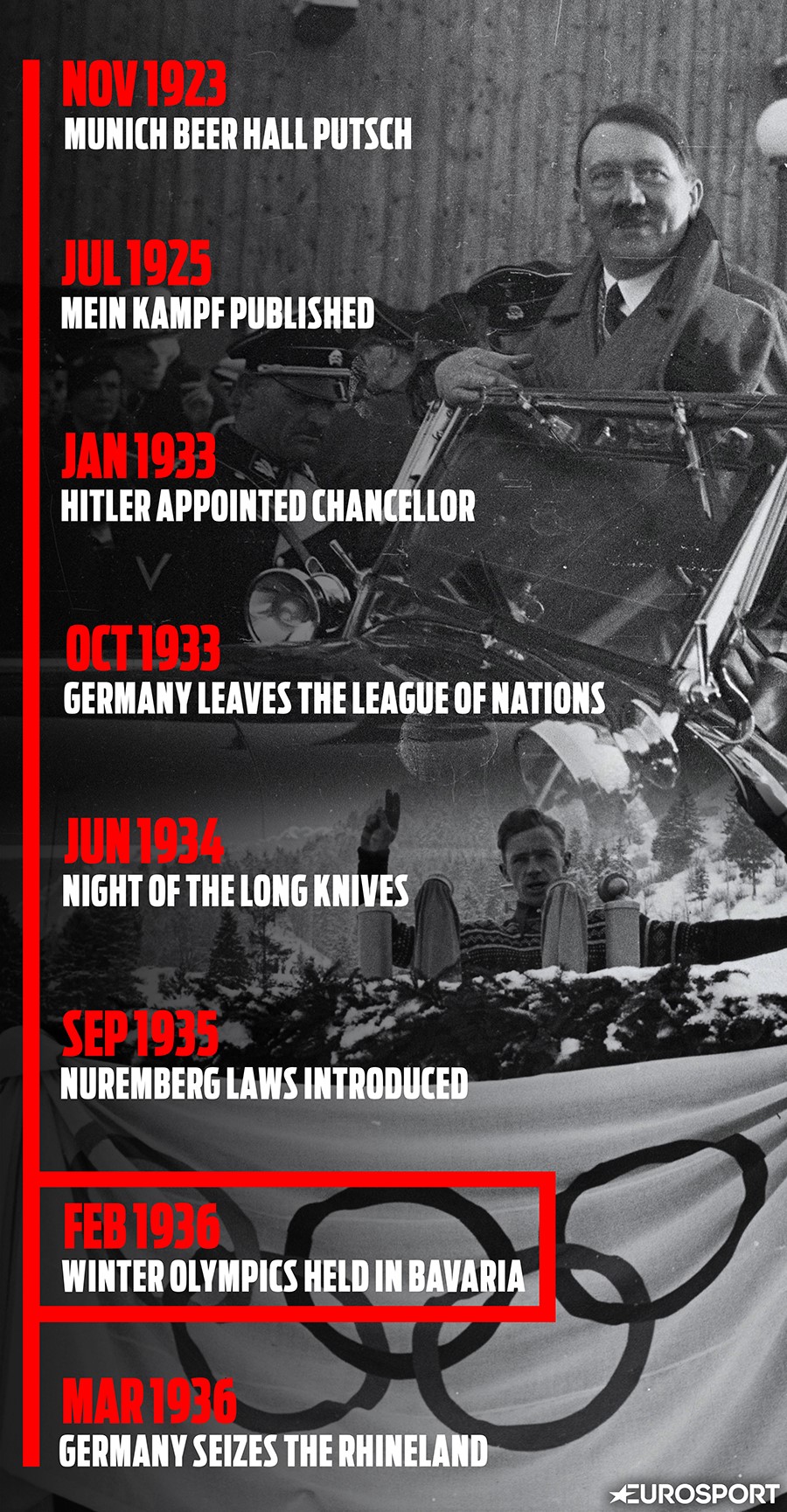
The Games were opened by Hitler amid much fuss, with Goebbels and Göring also in attendance – while organisers remained concerned about potential disturbances. In his book How Hitler Hijacked World Sport, Christopher Hilton explains: “The American team arrived and a special envoy from the Ministry of Foreign Affairs was sent from Berlin to ‘cosset the United States contingent’ while ‘special care’ was taken to protect the Spanish team from any form of racism because their swarthy features made them distinctly non-Nordic.” Meanwhile, all competitors had to handle the presence of brownshirts on the street, the reports too numerous to make official denials plausible.
Norwegian born American ice-skater Sonja Henie (1912 - 1969) leads a parade of Norwegian competitors at the Garmisch-Partenkirchen Winter Olympics
Image credit: Getty Images
Talking of Nordics, it was a Norwegian skater, Sonja Henie, who became Queen of the Games. A phenomenal talent who was already the double Olympic champion, her impact was cultural as well as sporting: she was the first to wear short skirts, white boots and incorporate dance moves into her routine, and it was because of her that figure skating was accepted as a serious endeavour.
And in Garmisch she won again, placed first by all seven judges and earning the favour of Hitler, whom she greeted with a Nazi salute and who she joined for lunch at his Berchtesgaden resort home, where he presented her with a signed photo of him. So popular was she that when she later appeared in Prague and New York, a police presence was required to control the excited crowds, and on retiring from the ice she enjoyed success as an actress in musical comedies.
3. Great Britain: An unlikely ice hockey powerhouse
The Harringay Greyhounds and the Harringay Racers in practice at London's new Harringay Centre (1936).
Image credit: Getty Images
The biggest story of the Games, though, came on the ice hockey rink, where Canada, four-time champions, had never failed to win gold. But though no one really thought that they could win, Great Britain were in pursuit, riding the wave of a local renaissance for the sport. The British Ice Hockey Association, founded in 1913, was only reformed after the war in 1923, but when their team placed third in the Chamonix Olympics of 1924, interest in the sport increased exponentially.
At St. Moritz in 1928, GB again did well, placing fourth, and as such the domestic game grew through the 30s. Once upon a time only Manchester Ice Palace had staged training and matches, but now London was in on the act: Wembley’s Empire swimming pool was frozen in the winter, and there were also rinks at Westminster, Earl’s Court, Golders Green, Hammersmith, Park Lane, Richmond, Streatham and Queens – as well as Hove, Birmingham, Bournemouth, Glasgow, Grimsby, Oxford, Southampton, Liverpool and Purley. Attendances at Wembley reached 10,000, twice a week, players were paid £10 a week, more than Division 1 footballers, and circulation of Ice Hockey World hit 50,000 a week.
This money generated by such popularity facilitated the recruitment of foreign players, amateurs nominally employed in grocery shops, warehouses and at the rink. And of course they were welcomed in traditional British style: the issue of draconian rules to which only they were subject. Those audacious enough to behave in unsportsmanlike manner, or indulge in on-ice violence – exactly the kind of thing that no one British would ever perpetrate or enjoy – faced heavy fines or deportation, and as such, ruckus was confined to locker rooms and bars where only a lucky few could enjoy them.
Famous Canadian ice hockey coach Clint Benedict trains young members of the Fleas how to score goals on the ice at Wembley. 60 schoolboys between 10 and 16 years of age have been formed into four teams the Fleas, Flies, Beavers and Bearcats, and recruite
Image credit: Getty Images
Standards were also elevated by foreign managers. Percy Nicklin, a Canadian, had managed Hawks to consecutive Allan Cups in 1932-33 and 33-34, but after failing to make it three in a row joined Richmond. And with him came Jimmy Foster, a goalminder who had once gone 417 minutes, almost seven full matches, without conceding. Nicklin imposed a rigid discipline: practice began at 7am and during the two hours it lasted, players were forbidden from talking and ordered about via megaphone. Next came breakfast and tactics, then an off-ice fitness session, a short break, and walking, running and skipping. On non-match days, there was a curfew of 11pm, and cigarettes were limited to two a day. Nor was this limited to Richmond: at Wembley, players were banned from owning cars, on the basis that “ownership tends to contribute to flabby muscles”.
In 1935, GB came third at the World Championships, and in the first stage led the eventual winners, Canada, before losing by the encouraging margin of 4-2; in the final group, they were beaten 6-0. But they weren’t about to leave it there. Previously, the team had largely comprised army officers and graduates living in the UK, but now it was full of proper players, and suddenly the influx of overseas players looked like a plan – which it was. And now, the task was to elevate the national side, so J.F. ‘Bunny’ Ahearne, the BIHA secretary, appointed Nicklin as manager and instituted a rule that each domestic team was to field at least four British-born players, then put out a message across Canada: “Were you born back home?”
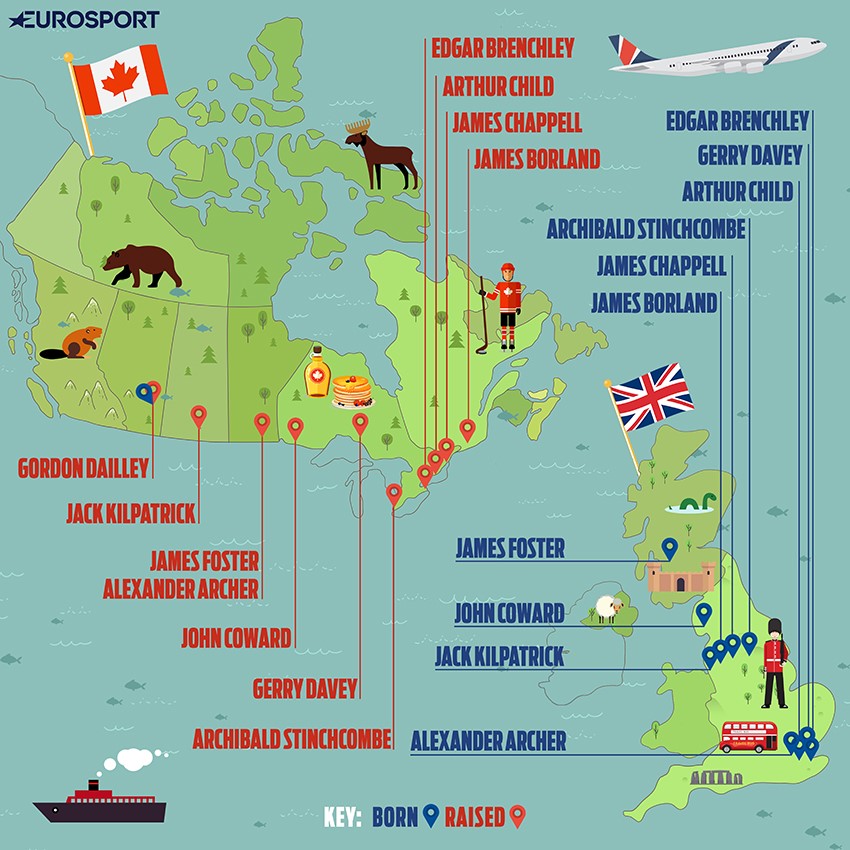
In the Great White North, people were less impressed by all this, with the Canadian Amateur Hockey Association worried about preserving the quality of its competition. The problem they had was that if players moved during the summer months, when they were out of contract, they did not need clearance so to do from any authority. So in September 1935, Ahearne, along with Carl Erhardt, the GB captain, sailed to Toronto to reason with them. Erhardt epitomised the kind of masculinity that so appealed to Tony Soprano – “a brilliant, very tactical diplomat who never ever lost his temper”, says his son Philip. “He just quietly manoeuvred things behind the scenes”. So an agreement was made that the BIHA would forbid the use of players who had not obtained permission to move from the CAHA, and the CAHA would not deny that permission to anyone who asked in the correct manner, after which Erhardt and Ahearne nicked off to seek more British-born players to move back across the Atlantic. “His force got the whole thing together, says Philip. “His will to get a good British team together”.
In general, the team was typical of the period: populated by those whose achievements were greater and lives more interesting outside the rink. Don Dailley, a defender, was born in Canada and earned his passage across the Atlantic by working on a cattle boat, then after the Games, he fought in the Second World War and was one of the first to find Hitler’s bunker, burning his body with petrol from nearby cans which now sit in a Canadian museum; Barnsley-born Archie Stinchcombe unwittingly helped run alcohol during prohibition and could only see out of his right eye thanks to a stray dart thrown by his brother; defender Bob Wyman, a former schoolboy long jump champion, held the British indoor half-mile speed skating record, and in 1934 won the outdoor 440 yards, a feat which earned him a Gallaher cigarette card, and after the Games, became a Lieutenant-Commander in the Royal Navy; Jimmy Chappell, born in Huddersfield but raised in Canada, was at Normandy for the D-Day landings; and John Coward would have moved to North America in 1907, except his mother was seriously ill, and they were therefore unable to board RMS Titanic as planned.
4. Going for gold
The ice hockey stadium in Garmisch (IOC)
Image credit: Other Agency
Once all the teams arrived in Garmisch, the Ligue Internationale de Hockey sur Glace held a meeting. During it, the rules of the competition were explained; Canada and USA were absent, so a further meeting was convened for their benefit the following day, and then, later in a week, the body held a full congress. At it, the CAHA complained about players “leaving the dominion without permission” – movement in the off-season was still a problem for them – and though GB strongly protested innocence, a vote was taken, and they lost. As a consequence, Foster and Alex Archer were suspended.
For a time, GB’s participation in the competition was in doubt, but three days into it, the Canadians relented. There was still no agreement as to the status of the players, but they agreed to compete against them, while the BIHA asserting its continuing refusal to acknowledge a difference in status between any of its players.
This was not the only issue bothering them: they also had to resolve the apparently thorny issue of whether or not to make a pre-match Nazi salute. “They really wanted to show respect to the public but not to Mr Hitler as such,” says Philip Erhardt. So after much discussion and a vote, they decided to keep their arms at an angle – “not too smartly and not too high”, which they believed was the sign of the Olympic movement, then gestured around the rink, rather than just towards Hitler. “They thought then that was fair, they could get away with that”, Philip Erhardt told the BBC.
Hosting ice hockey in the 30s was not a straightforward business. Some games were staged at the new Kunsteisstadion stadium, but others were played on the frozen Lake Riessersee, which had no boards around the side to catch checked players, and had to supply paraffin heaters to keep the benches warm. As such, some matches were badly attended, while Canada v Poland, the tournament opener, took place in a snowstorm and was delayed for a time while they tried to locate the puck.
In the first round the teams were divided into four groups of four, the most significant result Italy defeating USA – though in the event, USA qualified and Italy did not. Otherwise, Japan’s goaltender Teiji Honma attracted attention for wearing a mask, a frippery rarely seen in those days and which could not protect him from being beaten three times by GB, who also beat Sweden to qualify for the next stage; the Scandinavians joined them in round two, which comprised two groups of four with the top two in each progressing to a final round robin.
Members of the Japanese ice hockey team during a break in their match against Great Britain
Image credit: Getty Images
It was at this point that, figuratively speaking at least, things warmed up: GB were drawn with Germany, Hungary and Canada, whom they played first. And before the game, a problem: Gerry Davey, born in Port Arthur, Ontario before moving to England aged 16, fell ill. Davey was the team’s primary goalscorer – his final career tally of 43 is still a record – so he forced himself off his sick bed and onto the subs bench, where he had a good view of a crowd which, unimpressed by Canadian whingeing, was strongly behind his team. And almost immediately, he was involved in the game; seeing the way the Canadians lined up, Nicklin sent him on seconds after face-off, and seconds after that, he took a long shot which Francis Moore, in the Canadian goal, misjudged. With just 20 seconds gone, GB had a shock lead.
Canada, though, fought back strongly, only to encounter opponents prepared to hurl body in front of puck – no small sacrifice, given the rudimentary nature of their protection. But eventually Ralph St Germain equalised, and though GB almost scored again immediately afterwards, Canada dominated the remainder of the period.
During the break, Nicklin urged his players not to let Canada settle, assuring them that a mistake would come. The favourites were simply not accustomed to teams skating so hard and pressuring so often, chasing the puck about like a bunch of kids.
The British goal being attacked by Sweden during an ice hockey match at the Garmisch-Partenkirchen Winter Olympics
Image credit: Getty Images
On the ice, GB were marshalled by the superb Erhardt. Unlike the majority of his team-mates, he had not learnt to play in Canada but in Germany, where he attended prep school – his parents were German. So when the First World War broke out his family moved to America because, aged 17, he was old enough to be among the first round of call-ups because he was young enough not to ask questions, and his parents didn’t want him shooting his relatives. Having a German name in England at that time was hard – “German dogs were being kicked to death in London,” says Philip Erhardt, and the family changed the name of its business from C.A. Erhardt to C.A. Wargate.
Erhardt was 39 by the time the Games started, taking himself there in a 1933/1934 Lagonda M45. The only drawback of what must’ve been an enjoyable jaunt – he stopped along the way to visit his sister in Stuttgart – was the temperate conditions; heat came solely from then engine and through the exhaust manifold.
Despite his age, Erhardt’s skill and athleticism – he was also a fine tennis player, skier and water-skier – meant that he would often play more than 40 minutes in each game. And against Canada he produced an absolutely monstrous effort, symbolising and inspiring the mental fortitude which defined his team. “A very, very tough man”, says his son – as Canada’s Ralph St. Germain discovered. “Hit by a bodycheck like a thunderbolt and crumples like a tall brick chimney in a hurricane,” reported the radio commentary.
The British team in their dressing room (IOC)
Image credit: Other Agency
GB’s other key figure was Foster – known as “the Parson” because he’d once thought of entering the church. In 1930, he had broken a leg, a grave injury at the time, but fought his way back, and though some believed him to be past his best, in Garmisch he proved himself the best around, his monstrous performance the difference between victory and defeat.
Then, with 80 seconds to go and GB holding on for a respectable draw, a kind bounce of the puck sent Don Dailley streaking away on the counter. Alongside him appeared Edgar “Chirp” Brenchley – born in Sittingbourne but schooled in Niagara Falls, Ontario – and when Dailley’s shot was blocked, he had the easy task of sticking home the rebound!
Even so, Foster was called upon several times more in the time that remained, but he was equal to the challenge and Great Britain had done it! They celebrated their momentous achievement with handshakes, nods and three cheers for Canada, as was their wont, though the crowd were more animated, chairing some of them off the ice.
The following night, GB took on Germany, with an extra fourth period unable to separate the teams; because the rules were fluid, they eventually settled on a 1-1 draw and scarpered back into the warm. In the aftermath it was announced that the game would be replayed, before the decision was reversed and the teams took a point apiece.
Amazingly, GB were in action again at 9am the following morning. Given his exertions both on and off the ice, Erhardt was rested as Hungary were dispatched 5-1 – in front of Hitler, Goebbels and Göring. Both Foster and Dailley passed their passes up to the VIP box – which sat above the bench – for autographing, though when war broke out three years later Foster burned his. Dailley, though, did not, and when, in 1983, the Hitler Diaries surfaced, he produced it to help prove that they were fake.
In the photo above, the British team pose for a photo while Hitler stares into the camera from the balcony above (IOC)
5. Canada cry foul
Tensions rise as Canada face United States (IOC)
Image credit: Other Agency
It was at this point that things became controversial, when it transpired that the final round, for which GB had now qualified, would not quite be a round robin. Rather, each of the four teams team would play twice, against those it had not met during the previous stage, carrying over the result gained against its remaining opponent. Which was to say that GB and Canada would not meet again, which was to say that if GB could rustle wins against USA and Czechoslovakia, that would be enough for the gold medal.
This circumstance, described by the Canadians as “one of the worst manipulations in sporting history”, caused them not inconsiderable distress. They were unhappy that the opportunity to avenge their defeat had been denied them – such behaviour had never previously been part of the tournament – and the regulations had not been announced by the Olympic hockey committee. So Canada asked that all four teams play another, a suggestion overwhelmingly rejected.
And with good reason. In fact the regulations had been precisely announced by the Olympic hockey committee – twice. They were explained at the first meeting in Garmisch, and because American and Canadian delegates were absent, they were explained once more the followed day. No objections were raised.
So E.A. Gilroy, president of the CAHA, blamed his delegation’s inability to understand French, and by way of revenge, Canada cancelled matches scheduled to take place in Europe after the Games. This, the world agreed, really showed everyone.
Meanwhile, USA beat Czechoslovakia and so did GB, pumping them 5-0. They now had four shutouts in seven games and knew that if they beat USA, they were champions; any other outcome and their destiny was not in their own hands.
Incredibly, the teams shared six scoreless periods before deciding enough was enough, and at the end, the stadium announcer informed the crowd that GB had won gold, though this was not in fact so: if USA could beat Canada by 5-1 or better, that would be enough to nick top spot. But still bushed from the night before and facing a team fired by pride and injustice, they sputtered to a 1-0 defeat; Great Britain were Olympic champions!
Thanks to Philip Earhardt and Rob Jovanovic. Rob's book on the subject, Pride and Glory, is well worth your time – if you're lucky enough to find a copy.
/dnl.eurosport.com/sd/img/placeholder/eurosport_logo_1x1.png)
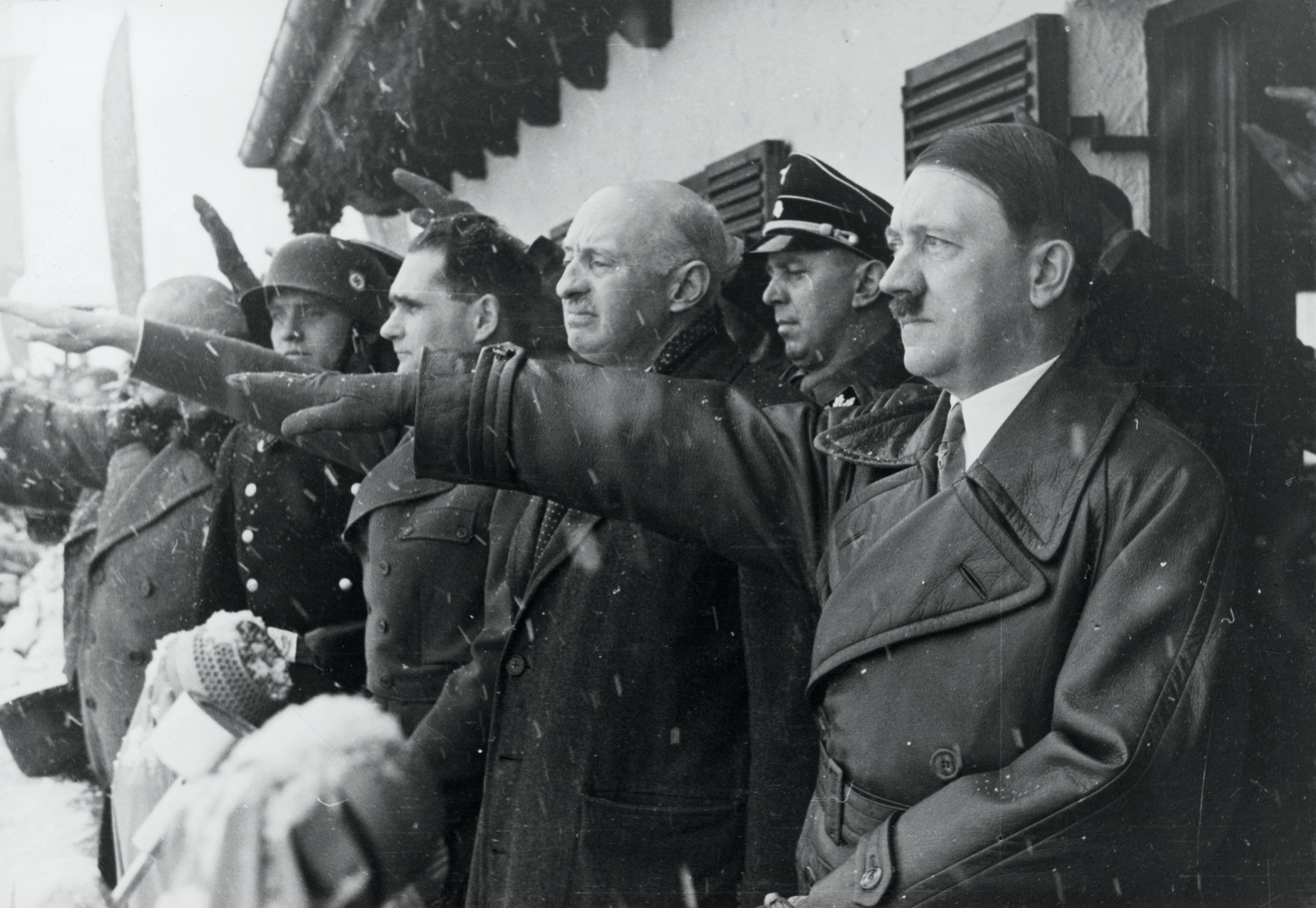
/origin-imgresizer.eurosport.com/2018/01/27/2255573-47010250-2560-1440.jpg)
/origin-imgresizer.eurosport.com/2018/01/27/2255572-47010230-2560-1440.jpg)

/origin-imgresizer.eurosport.com/2018/01/27/2255241-47003610-2560-1440.jpg)
/origin-imgresizer.eurosport.com/2018/01/27/2255236-47003510-2560-1440.jpg)
/origin-imgresizer.eurosport.com/2018/01/27/2255238-47003550-2560-1440.jpg)

/origin-imgresizer.eurosport.com/2018/01/27/2255243-47003650-2560-1440.jpg)
/origin-imgresizer.eurosport.com/2018/01/25/2254342-46985630-2560-1440.jpg)
/origin-imgresizer.eurosport.com/2018/01/27/2255250-47003790-2560-1440.jpg)
/origin-imgresizer.eurosport.com/2018/01/27/2255252-47003830-2560-1440.jpg)
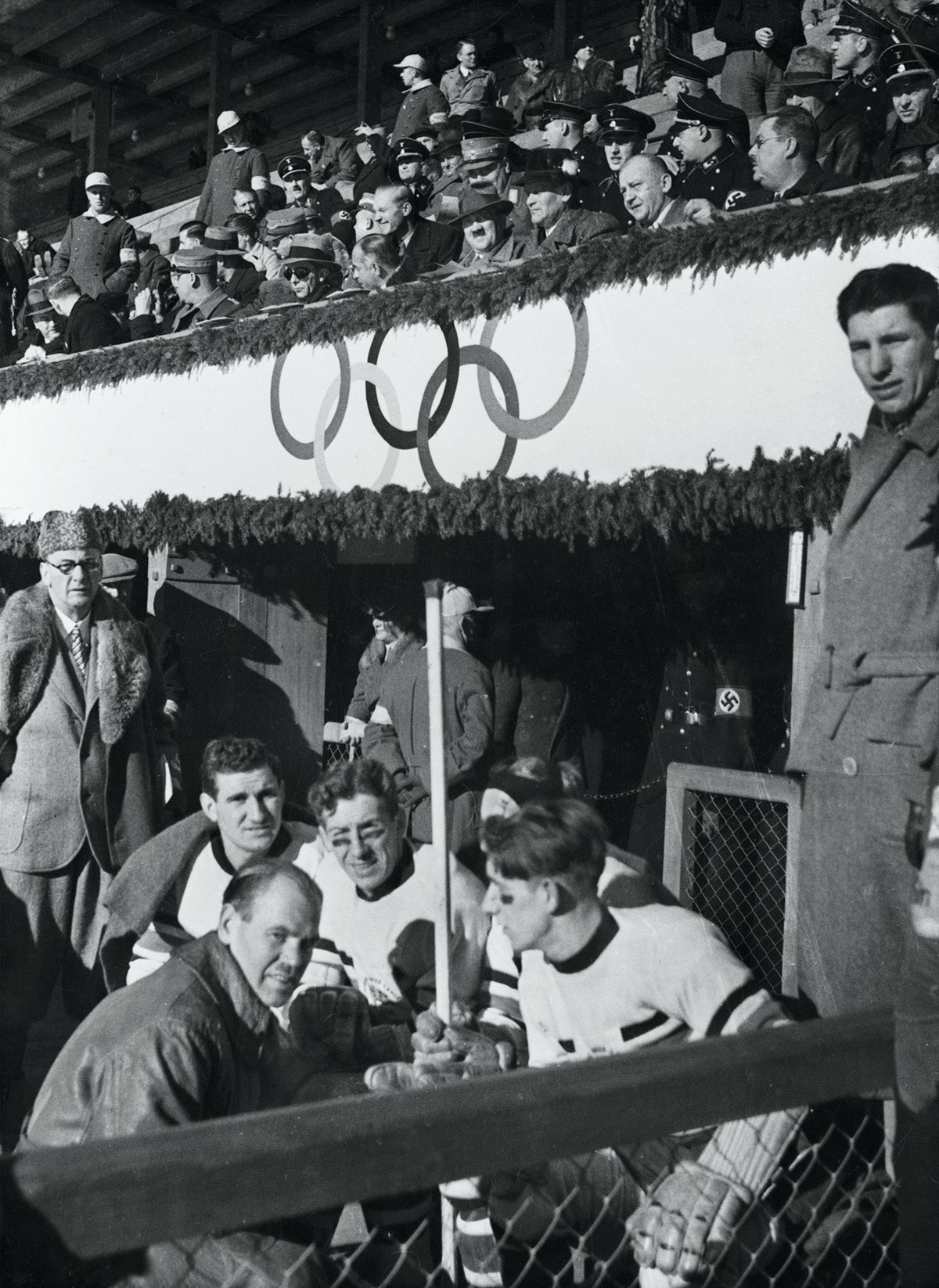
/origin-imgresizer.eurosport.com/2018/01/27/2255273-47004250-2560-1440.jpg)
